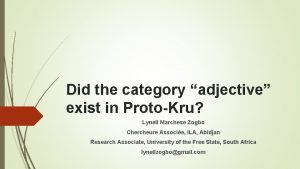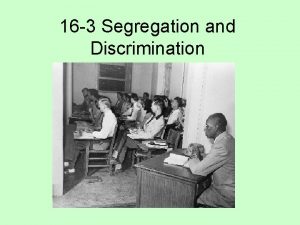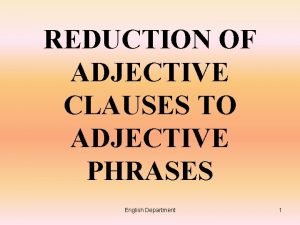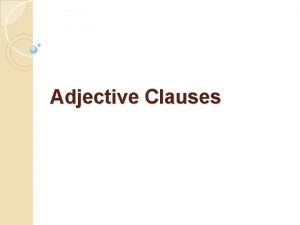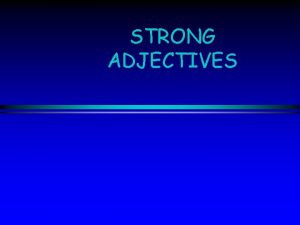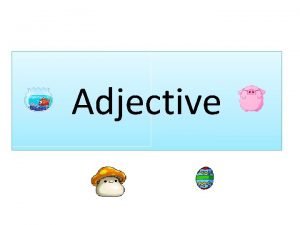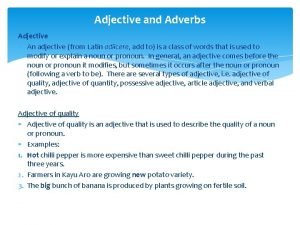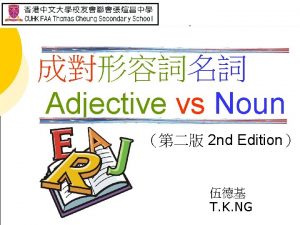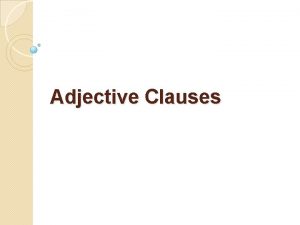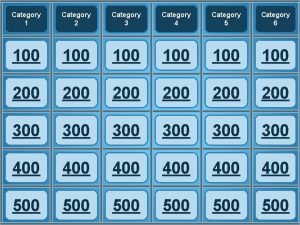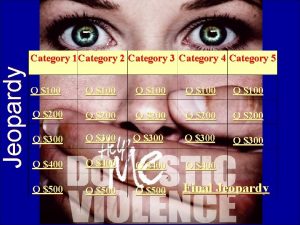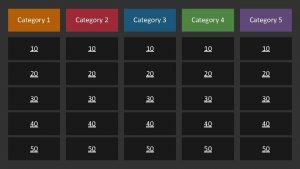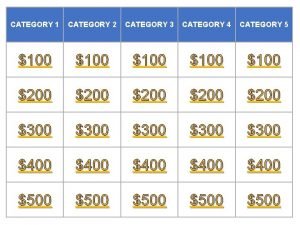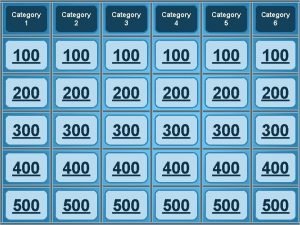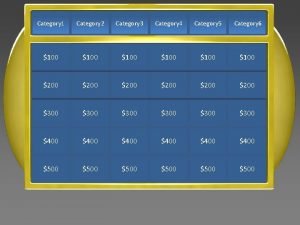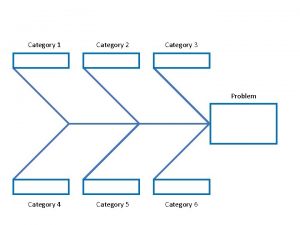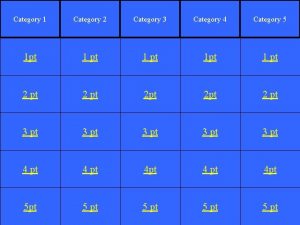Did the category adjective exist in ProtoKru Lynell





















- Slides: 21

Did the category “adjective” exist in Proto-Kru? Lynell Marchese Zogbo Chercheure Associée, ILA, Abidjan Research Associate, University of the Free State, South Africa lynellzogbo@gmail. com

Kru still “dangling” out there

West-east divide : major indicator

Question of Adjectives : “Many works on African languages, including some that might be expected to be among the most reliable, show a remarkable lack of linguistic sophistication in their treatment of noun modifiers. The term ‘adjective’ may be applied to any form which is reflected by an English adjective in translation, without reference to its derivation or grammatical function in the language being described” (1973: 249) Wm Welmers African Language Structures Denis Creissels : “lorsque les linguistes se sont mis à décrire les langues parlées hors d’Europe, la pratique s’est instaurée de désigner comme ‘adjectifs’, non seulement des unités nominales dont le statut syntaxique présenterait des analogies avec celui de nos adjectifs, mais aussi toutes sortes d’unités qui dans la traduction apparaissent comme l’équivalent de nos adjectifs » (p. 176). Universals, Proto NC, psychologial reality, cognitive world view, discourse use (attributive vs predicative) Thompson, Post,

Adjectival notions are expressed in many ways in Kru q. Adjectival verbs : Ɛ –za ‘it is red’ q. Periphrastic constructions : BE AT/HAVE/DO ‘X’ q Ideophones : Ɛ -nι’e-e -bhli! Ɛ -kpe’o ‘wee. ‘He’s completely black! He’s all black! q. Compounds: zƐ-zƐ-zere spoiled-spoiled fish (Koyo) “yri-nmͻ-budu eyes-good-house (Nyabwa) q. Relative clauses q‘True adjectives’ : N ADJ QUANT REL-S

Adjectival V’s dominant, most lexical items, true verbal behavior, most ‘reconstructable’ Verbal position as subject/topic : sakaa a sù. ‘The rice is hot’ (Lakota Dida) Negate as verbs : ‘Nyuo ‘nι wͻtͻ. ‘The water isn’t cold’ (Neyo); Bhitéa àá pɔɔlε HLL ‘The house is not white’ (Lakota Dida) Default perfectives, can take imperfective aspect : -kͻbι-ι zaan’o ‘The rice is ripening (reddening) (Nyabwa) Can take TENSE : cͻ na nmͻ-ma wͻ~ ‘The palm b. was sweet DBY’ (Klao) Can carry verbal suffixes: process, subordinate, declarative, applicative : Ka : MƐle’ ‘bƐ-a, ka-: : Pͻͻ’ ‘bƐ a zʌmʌ ɔ zʌmʌ n’a (Godie) way M big-SUB, way P is-big (Krahn) it’s red …reddens he red APPL-it (*ne/le) Enters into compounds : zƐ-zƐ-zere (Koyo) cf. bhlanyɔ (kill-person)

Adj verbs take verbal particles, numerous semantic distinctions-extremely productive -tƐ …. ti ‘to be long’ (river) -tƐ…. . ya ‘to be big’ (person) -tƐ…. . ’mʊ ‘to be deep’ (well) -tƐ…. . gbo ‘to be far’ (village) -nmͻ…kwa ‘to be ok, suffiicient’ -nmͻ…. wͻn ‘to be delicious’ -nmͻ…. ”yri li ‘to be good, beautiful” -nmͻ…. ”yi ti ‘to be worthy’ -nmͻ…. ’kpa ‘mʊ ‘to be vigilant in regards to cleanliness’ -nyni …. ”yri li ‘to be bad -nyni…. wͻn ‘to be spoiled” -nyni…. ’kpa ‘mʊ ‘to not be vigilant in regards to cleanliness’ (Nyabwa) Cycles of recreating expressions : nmɔ/nyni…-jri i ‘to be beautiful/ugly’ (good in the eyes) (Wobe)

Semantics of Property Concepts CORE PROPERTY CONCEPTS : DIMENSION, VALUE, COLOR, VALUE, DIMENSION PERIPHERAL PROPERTY CONCEPTS: PHYSICAL PROPERTIES HUMAN PROPENSITY QUANTITY (Kokora, 1976, quoting Dixon, 1977, 82, 2004) NOT necessarily in binary pairs some pairs have a dominant member (big-little) some items are negated ‘to be tired’ vs. ‘not to be tired’

WEST EAST COLOR: 3 way Proto Kru (PNC? ) red-white-black To be red To be white To be black Krahn zanɩ ‘plu ‐kpe Wobe Guere Glaro Nyabwa Tepo Kru Klao Kru Bassa Bakwe Proto west To be red To be white To be black Kouya ‐za pͻlʊ ylu Dida Lakota ‐zalɩ Pɔɔlɛ Dida Yokoboue -za Pulu ‐kpo ‐sain’ ‘’plu kpe Neyo Godi JR ‐z. A zaan/zaano/ ‐zana hlu BH ‘’plu ‐kpe Godie Kagbewɔlɩ pɔɔ kpə Koyo za pɔn kpe Guebie ɟalɛ 1. pɔpɛ 2. kpa 4 flo ML Bete Kpokolo Bete Guiberua Bete Daloa ‐za Pɔnʋ julu Proto East Krou ‐za *pɔL *kp. V /? *ylu plɛ H jre M also: éteindre **ɔ ni zizan **ɔ ni kpii ‐flɔɔɔ ‘pɔlɔ ‘kpo ro *za(n) #plu *kpe

VALUE To be good To be bad To be bitter To be sweet to be straight To be good Krahn nmɔ : nyni nenɛ: mene slɛ 'i Kouya 'nanɩ -kalɩ mεnɩ Wobe nmɔ nyni “kae Dida Lakota Guere Dida Yokoboue nanɩ ‐nyu kalɩ mɛnɩ Glaro Neyo sri sa Nyabwa ‐nmɔ ɔ nɔ ‐nyni ‐kma ‘mɩɩ Godie JR nʌ ‐nyu kʌ ‘mɛɛ nyre le kla yi 'srɛɛ ''yi sii ye o Godie Kagbevɔlɩ nʌ ʌ ‐nyu kʌ ʌ mɛɛ gəə ‘yi Koyo nan ‐nyu Gbadi kalɩ…m mɛ lɛ Bete Guiberoua Bete Daloa ‘nanɩ ‐nyu kalɩ mɛnɩ slɛnɩ Tepo Kru nɔ ('yi nyre lɛ) 'yi lɛ kla 'sɩsrɩ H 'sii HM M 'o ye Klao Kru nmͻ M Bassa Bakwe ‘na bʋbɔ ‘mɛnɛ Proto west #namɔ *-nyini #k. La… #mene 'klɩgʌ *sl i/e Bad Bitter sweet straight Ayizi ɲre yɩ Proto East *‘na *nyu #ka. L *mɛ #sl. I/E

“TRUE” ADJECTIVES in Kru: some generalizations Adjectives are post-nominal. The class of ‘true’ adjectives is usually very small and appears to be closed and non-productive (can be listed, 6 -20? , Western more numerous) Subclass of adjectives show signs of agreement (singular-plural and/or class) The presence of an adjective often provokes tonal changes within the NP. The adjective class is not homogeneous, i. e. there are various sub-classes and exceptions, based on different kinds of morphological and tonal behavior. Ex, Godie, Krahn Some “adjectives” look like reduplicated adjectival verbs Some “adjectives” look nominal.

Singular-plural agreement TEPO KRU TCHIEN KRAHN SG PL faka cicre fakɩ cicrei ‘little knife(s) nyɔ klàbá nyʋ klàbɩ ya ká yɩ kɩ ‘old pot(s) important person(s) hru petú hri peti ‘long road(s) de zʋn dɩ zʋɩn ‘bad thing(s) yu yrayrʋ yuó yrayrɩ ‘new child’

Class (and number) agreement Godié (jlukͻwalι) Noun + Adjective + Demonstrative nyʉ kpɔ kʌ dɔ nɔ ɓu tu kʌ dʋ nʋ mlɛ kʌ d ɛ nɛ nmlə kʌ dʌ nʌ ɓı tı kʌ dɩ nɩ ‘this big (great) man’ [ɔ ] ‘this big house’ [ʋ] ‘this big animal’ [ɛ ] ‘this big bird’ [a] ‘these big houses’ [ɩ ] nyʉ kpa kʌ dʋa nʋa ‘these big (great) men’ [wa/ʋa] (Bete de Guiberoua, de Daloa, but also Bakwe! Areal spreading?

Why is it difficult to reconstruct the ‘adjective’ class for proto-Kru? Class is very limited (6 -20 max); compare to verbs (50+) The class is not homogenous Besides 3 colors, “new”, and #”big”, almost impossible to reconstruct more adjectives They act like nouns!

Postnominal “Big” and “small” big Little Kouya K d. V Krahn : klaba’/ ‐kolu’ ‐bɛ: / ’chɛ Dida Lakota ‘kad. V ‘tɩklɩl. V Dida Yokoboue kad. V co Neyo kad. V Godi JR k d. V ‘tεkεlɩε ? -lie (story) Godie Kagbewɔlɩ k d. V Koyo seeliye Bete Guebie tɛkɛlɪ Bete Kpokolo Bete Guiberua Bete Daloa kad. V PEK [1] Some pronounce Kla? Wobe as –teepe. [2] No vowel harmony Guere Glaro Nyabwa -klagba’’ -toope Tepo Kru gblaka MH ‘cicrɛ H BH Klao Kru Bassa vɛnɛ LL Tííwè/mɛnɛmɛ nɛ HHHH Bakwe kpakö Ayizi kpasa (? ) Pɩtrɛ jɩ

The “adjectives” look like nouns q They pattern as nouns: Daloa Bete: Pͻlʊ/-amӧ –Бa “It’s Paul/me” “Kadͻ -Бa ‘It’s the big one’ ͻ wʊ la kadͻ mӧ (POST) “He was (already) grown q They can be possessed: 'ɛ ‒klagba mo'o! It’s the big one (Nyabwa) Á yrayrʋ nͻ lε yi ‘The new one is beautiful’ (Tepo) q They have tonal behavior similar to N-N constructions : dibi’ : kolu’ : nmaa’e ‘a fine big deer’ (Krahn) naa 2 sͻ 3 s. A 2 ‘dry catfish’ (Godie, 2 3) cf. nyie 11 + dʌbʋ12 -> nyidʌbʋ132 ‘water + duck’ (‘wild duck’)

Unexplained forms PL or BASE FORM + SG “ADJ” = N ADJ (SG) Nglι vàye H LM ‘a tall woman’ (Neyo) women tall-SG bhìti nana ‘a beautiful house’ cf. bhìti nánɩ ‘beautiful houses’ (Dida Lak) houses beautiful-SG ‘ gɔ H nánʋ ‘a beautiful car’ cf. gɔ nánɩ ‘beautiful cars’ (Dida Lak) nyikpa nyonyo/ dɔgba-a/ lolo-o ‘an ugly man, the fat/new man’ (Koyo) men: PL ugly: SG dɔ- yu elephant child ‘a baby elephant’ (Tepo Kru) BASE N kayuó yrayrɩ ‘new houses’ = house its new ones X it’s one

Phonotactic features of “Adjectives” : many ending in LV/DV/NV/RV Tepo Godie Bete Dida Klao Kouya Krahn nanɔ ‘good’ 'nanɩ pru ‘white’ cícrε ‘little’ tεkεl. Iε ‘little’ kʌd. V ‘big’ kad. V zʌl. V ‘red’ z. Vr. V ‘red’ yrayrʋ ‘new’ l. V ‘new’ bolu ‘long’ tnɔ -tlʋlʋ yal. V ‘fine’ mεnɩ bhòlʋ The PRONOUN LV does exist along with the LV/DV ‘thing’ : dhulu

N + Adjectival verb + NOM/PRO N + agreeing adjective nyikpɔ za - lɔ nyikpɔ zalɔ man red one (HUMAN SG) man the light skinned one ‘the light skinned man’ N N ADJ +HUM, +SG Also consider the prominence of THING ͻ lƐ-kadͻ ‘He’s fat’ (Neyo, Dida, Godie) he thing-big b. ATAa dƐƐ (non sacred) (Bakwe) Village thing

New scenarios possible Standard view: Proto Kru had a full blown N + ADJ paradigm with class agreement which was retained in Eastern Kru and lost throughout Western Kru OR New view: Eastern Kru had 6 classes (4 SG, 2 PL) which reduced in Western to 2 SG, 2 PL Eastern Kru innovated adjective formation and agreement through a N N construction based on PRONOUN AGREEMENT (*DFM : Pronoun agreement higher on the hierarchy than ADJ agreement) This extensive agreement spread as an areal feature into Western Bakwe (like central vowels) Western Kru never developed class agreement! *this explanation provides a mechanism for creation of agreement phenomenon in Kru

Did Proto-Kru have the category “adjective”? 5 “adjectives” seem reconstructible If the system existed, it was minimal Adjectival notions in Kru are closely linked to verbs and noun constructions b. ATAa dƐƐ But languages seem to like adjectives! And there appears to be something pushing languages to establish this category! Implications for what we know about NC? Thanks to Gneba, Sande, Singler, Slager, Thalmann, Wilson, documents from Cocora, Egner, Gnahoure, Grah, Guehon, Kokora, Sauder, Saunders, Seri
 E-rate category 1 vs category 2
E-rate category 1 vs category 2 Exist adjective
Exist adjective Lucius verus gladiator
Lucius verus gladiator Haplogroup k ashkenazi
Haplogroup k ashkenazi Chapter 16 section 3 segregation and discrimination
Chapter 16 section 3 segregation and discrimination Racial etiquette region
Racial etiquette region Changing adjective clause to adjective phrase
Changing adjective clause to adjective phrase The old man next to me on the pier was muttering to himself
The old man next to me on the pier was muttering to himself Base strong adjectives
Base strong adjectives Adjective dependent clause
Adjective dependent clause Lời thề hippocrates
Lời thề hippocrates Hươu thường đẻ mỗi lứa mấy con
Hươu thường đẻ mỗi lứa mấy con đại từ thay thế
đại từ thay thế Quá trình desamine hóa có thể tạo ra
Quá trình desamine hóa có thể tạo ra Vẽ hình chiếu vuông góc của vật thể sau
Vẽ hình chiếu vuông góc của vật thể sau Công của trọng lực
Công của trọng lực Thế nào là mạng điện lắp đặt kiểu nổi
Thế nào là mạng điện lắp đặt kiểu nổi Dạng đột biến một nhiễm là
Dạng đột biến một nhiễm là Bổ thể
Bổ thể Vẽ hình chiếu đứng bằng cạnh của vật thể
Vẽ hình chiếu đứng bằng cạnh của vật thể độ dài liên kết
độ dài liên kết Kể tên các môn thể thao
Kể tên các môn thể thao

